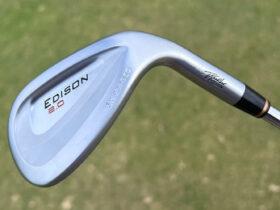The Putting Arc Review
WHERE DID YOU GO TO SCHOOL?
There are two basic schools of thought on the modern putting stroke. The first is the “straight-back/straight-through†school, which advocates keeping the putter head on a straight line all the way through the putting stroke, so that the face of the putter always remains square to the target. Advocates of straight-back/straight-through putting, including Phil Mickelson’s short-game guru Dave Pelz, preach that this method minimizes the potential for mishits because the putter face always stays on line and perpendicular to the target line.

“Not so fast!†claim supporters of the second type of putting stroke. Advocates of the “arc†putting stroke, including former pro and current instructor Stan Utley, assert that a straight-back/straight-through stroke requires an unnatural movement of the body that is both uncomfortable and difficult to consistently repeat. Instead, arc putting proponents urge a pendulum stroke that travels, not surprisingly, on an arcing path from inside the target line, to square at impact, and then back inside the line. During the stroke, the face of the putter remains perpendicular to the line of the arc and impact occurs at the point on the arc where the putter face is square to the target line.
Each method has its own advantages and disadvantages, and ultimately the decision of which technique works best for your game boils down to individual comfort, results, and practice, practice, practice!
PRACTICE MAKES PERFECT
If you are a subscriber to the straight-back/straight-through school of thought, the visualization of the stroke is simple enough: just make sure the putter head travels in a straight line. And if you need a training aid, lay a couple of clubs or wooden dowels on the ground parallel to the target line and just fractionally wider than the putter head.
But what if the arc putting stroke feels best for your game? How can you practice in a way that fosters a repetitive and predictable putting stroke? How do you know if you are following the same arc every time? Well, that’s where teaching professional V.J. Trolio comes in. Trolio is a co-inventor of a line of training aids dubbed “The Putting Arc.†The Putting Arcs are stationary guides with one side curved into an elliptical arc that Trolio and his team have determined represents the mathematical calculation of the best path for a putter to take during the putting stroke. (For the mathematically and geometrically inclined golfer, the precise calculations can be found on the Putting Arc website Here.)
PUTTING IS AN ARC FORM
The Putting Arc sits on the putting surface with the straight edge facing the toes of the golfer. The ball is then placed so that the back edge of the ball lines up with the apex of the arc, which is marked with a guide line on the Putting Arc. The golfer takes a normal stance with the heel of the putter resting against the curved edge of The Putting Arc. During both the back and forward portions of the stroke, the heel of the putter “rides†along the curved edge the Putting Arc, while the putter face remains at a 90 degree angle to the curved edge.
Trolio recommends first practicing on the Putting Arc without a golf ball until the correct club position can be maintained and repeated throughout the stroke. According to Trolio, as long as the stroke is made using a shoulder-rotated pendulum movement with no manipulation of the hands or forearms, the correct path should occur naturally. Once a golfer can consistently keep the club in the proper position throughout the stroke, he or she can begin practicing a six foot level putt with a ball.
For those who have difficulty keeping the face of their putter perpendicular to the putting arc, the company offers an additional attachment called the Arc Glider (MSRP $7.95) that resembles a modified “T†and forces the putter face to stay at a 90 degree angle to the arc line.
Trolio is so confident that the Putting Arc will improve your putting stroke that he offers a money back guarantee. He also claims that, of the first 18,000 Putting Arcs shipped, fewer than 10 have been returned by golfers claiming the product did not improve their putting.
WHAT WE TESTED

THP tested the Putting Arc Deluxe model, which is intended for indoor/outdoor use. Also tested was the smaller T3 model, which is designed for outdoor use only and primarily as a lightweight travel alternative or supplement to the larger and heavier Deluxe model.
Made of wood and spanning 36 inches (91.4 cm), the Putting Arc Deluxe (MSRP $89.95) weighs in at a hefty 8 pounds (3.6 kg). The smaller and lighter T3 (MSRP $35.95) is only 20 inches (50.8 cm) long and weighs 7 oz. (198 g.) Also available, but untested by THP, is the 33-inch (83.82 cm), 2 pound (0.9 kg) MSIII model, which is made of plastic and is suitable for both indoor and outdoor use (MSRP $69.95).

The Deluxe model was tested both indoors in conjunction with the Boomerang Dynamic Putting System (available from a different manufacturer), as well as outdoors at a local practice putting green. The T3 model was tested only outdoors, per its suggested use, at the same local practice putting green.
Due to unusual local weather conditions more suited to igloo building than putting, outdoor testing was limited. Testing will resume once practice putting greens are free of snow and any changes or additions to the review will be posted here. However, based on the outdoor testing that was performed prior to the winter weather, I do not expect any changes or amendments.

Both models were testing using two different blade style putters (PING Redwood Anser and Scotty Cameron Circa ’62 No. 1) and a mallet style putter (PING Karsten Craz-E).
WHAT WE THOUGHT
Using the Putting Arc with Blade Putters: With blade style putters, both models of the Putting Arc worked as intended. The putter travelled easily along an arc that felt natural and comfortable. There was no feeling that the smaller muscles of the hands and forearms were being manipulated in order to keep the putter on line and square with the target. The Deluxe model stayed in place both inside and outside because of its significant weight, while the T3 was easy to anchor to the putting green with two ordinary tees.

Using the Putting Arc with Mallet Putters: In contrast to blade style putters, mallet did not always seamlessly with the Putting Arcs. Because many mallet putters do not have a traditional heel like blade putters, they cannot slide on the arc in the same balanced way that a blade putter does. Mallets with a traditional square heel, like an Odyssey 2-Ball Blade, should work fine. Others, like the TaylorMade Rossa Inza, will be difficult to keep properly aligned on the Putting Arc. The PING Craz-E we tested was somewhere in the middle. It required more effort to keep the putter properly aligned than a blade putter, but it was possible. Users of a mallet putter should demo the Putting Arc at a local store to make sure it will work the specific mallet. Fortunately, one of the positive aspects of the Putting Arc is that anyone can get a good idea of whether the arc stroke it promotes feels natural to them by trying it out a few times in a local store,. While you may not immediately drain 9 out of 10 putts as advertised by the company, you will be able to get a good idea if the Putting Arc can help your game.
Effectiveness of the Putting Arc: During the first few days of using the Putting Arc, I had problems with pulling my putts and, to a lesser extent, controlling my pace. But even during those first practice sessions, my stroke with the Putting Arc felt natural and fluid, which motivated me to keep practicing. After a few days, I was able to keep the ball on line and better control my distance. I also discovered that I had not been using enough forward press in my setup and stroke.

As each day passed, my putting stroke became slightly more engrained. After a few weeks of use, I am confident that continued practice with the Putting Arc will improve my putting stroke and promote muscle memory. Historically, I’ve been a decent, albeit not exceptional, feel putter. But regular practice with the Putting Arc should improve my consistency even more. Overall, I am satisfied with the Putting Arc and I believe it can legitimately help those struggling to achieve a consistent putting stroke.
Which Model is Right for You?: As described above, The Putting Arc company makes three models of their Putting Arc: (1) the large, heavy, wood “Deluxe†model; (2) the full-size, lighter, plastic “MSIII†model; and (3) the small, featherweight, plastic “T3†travel model.
If you want something primarily for indoor use, then your choices are between the Deluxe and MSIII models. The Deluxe is nicer looking, heavier, slightly longer, and suitable for occasional outdoor use. However, it doesn’t fit in the pockets of a golf bag and is bulky to transport. At almost $90, it is also relatively expensive for a training aid.

If you want something that stays in your golf bag, then the choice is between the MSIII and the T3. The T3 fits in the long zippered pocket of most carry bags, is significantly less expensive than the other models and, at 7 ounces (198 g), is lighter than two sleeves of golf balls. However, because of its reduced length the smaller T3 only allows for practicing shorter putts, and it cannot be used indoors (unless you don’t mind nailing it to the floor, which we do not generally recommend.) The Putting Arc company recommends the T3 for travel use or as a supplement to the Deluxe or MSIII models.
For most players though, the MSIII will probably strike the best balance between functionality and convenience. It works both indoors and outdoors, is relatively lightweight, and it is only 3-inches (7.62 cm) shorter than the Deluxe model. At $69.95, it is still somewhat expensive for a training aid, but Putting Arc Inc.’s money back guarantee provides some insurance if it doesn’t help your putting.
JUST THE FACTS:
WHO (is it for?): All golfers using a blade style putter, and some golfers using a mallet style putter, who struggle to find a consistent, predictable, and natural-feeling putting stroke.
WHAT (does it work with): Your own putter, ball, and putting surface.
WHERE (can you use it?):
Deluxe – indoor/outdoor.
MSIII (not tested) – indoor/outdoor.
T3 – outdoor only (must be secured to the ground).
WHEN (can you use it?): Anytime you practice putting.
WHY (would you want to use it?): Because improving your putting is the quickest way to lower your score.
HOW (does it work?): By forcing the putter to take the perfect putting path, the golfer creates muscle memory.
DOES IT WORK: Yes. But like everything else in golf, the Putting Arc is not an instant fix to your putting woes. It takes practice. However, by removing the putting path variable, the Putting Arc permits a golfer focus on other aspects of the putting stroke; such as pace and clubface position at impact. A Putting Arc could be particularly beneficial to those suffering from the yips or just learning the arc putting stroke.
LONGSHANKS RATING: Birdie.
SPECIFICATIONS:
Putting Arc Deluxe
Material: Wood/Wood Product
Length: 36 inches (91.4 cm)
Weight: 8 lbs (3.6 kg)
Use: Indoor/Outdoor
Price: $89.95 MSRP
Putting Arc MSIII (not tested)
Material: Plastic
Length: 33 inches (83.82 cm)
Weight: 2 lbs (0.9 kg)
Use: Indoor/Outdoor
Price: $69.95 MSRP
Putting Arc T3
Material: Plastic
Length: 20 inches (50.8 cm)
Weight: 7 oz. (198 g)
Use: Outdoor
Price: $35.95 MSRP
Contact Information
The Putting Arc Website
sales@theputtingarc.com
1-800-898-0701 (9 a.m. – 5 p.m. CST, Mon-Fri)













I have looked at the plastic version a few times and really thought about pulling the trigger each time. My fear is just the weight of the wooden one when lugging it around. However for use in the house, this would be ideal. I just wonder if something could be homemade that does the same thing.
Great read. Makes me want to run out and buy one of these.
Extremely well-written review.
Solid review. Can you describe a little bit of what it was like dragging this thing to the course? It seems as though that would be my only detractor from getting one.
Thanks for the insigt. I have been looking at a putting gadget for a while and this one looks promising. The price is a little high, but if it works, it is worth it. Have you found that your stroke has stayed the same since you have tried it out?
Love the reviews here. I have this device (plastic one) and use it all the time. I think the reviewer hit the nail on the head with this one.
Dave-
I wouldn’t want to lug the Deluxe model (the 8 lb wood model) around very often. It is big and bulky – not easy to throw in the bag and just go.
If you are looking for model to work both at home and on your local practice green, I would recommend the MSIII model. It’s still long (33″), but it’s plastic and much lighter than the Deluxe model. It’s also $20 cheaper.
Brad-
I’m still working on converting the practice stroke with the Putting Arc into muscle memory. It’s not completley automatic yet, but now I can feel when my stroke gets off line or when I try to manipulate the putter instead of trusting the pendulum stroke.
I was a decent putter before, but my stroke sometimes got inconsistent when I was faced with a difficult or stressful putt. I think continued practice with the Putting Arc will allow me to trust that my stroke is on the right path.
I tried the MSIII at the local golf outlet recently. I practiced the arc without a ball 6 times, then 6 more times with a ball to a short cup then took the same stroke to their flat indoor green and immediately drained 3 15 footers centercut with a perfect end over end roll! I was stunned, only slightly heard of the arc option. Looking forward to more arc practice. My straight back and through is very inconsistent, maybe a solution is at hand.